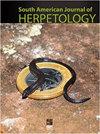棘齿亚科存在防御性假自切机制吗?标题刺花属植物的研究
IF 0.7
4区 生物学
Q4 ZOOLOGY
引用次数: 1
摘要
摘要假自切可能是鳞翅目的衍生特征,发生在失去自切能力的分类群中。一般来说,能够采用假自切作为防御捕食者的防御策略的物种在一系列的爬行动物收藏中呈现出高频率的损伤尾巴。我们评估了巴西大西洋雨林中三种主要同域的棘球菊物种(E. cephalostriata, E. cyanopleura和E. undulata)的数据,以验证先前的假设,即棘球菊物种使用它们的尾巴进行防御。这一假设来自实地考察期间的轶事观察,并被科学收藏中出现尾巴断裂的标本数量所加强。一般来说,在这些物种中,受损尾巴的频率与其他假自切已被证明的物种相似。统计分析显示,在被分析的物种中,尾巴断裂频率在两性之间没有差异,在为cyanopleura定义的两个地理类群之间也没有差异。与此相反,我们发现青胸膜胸鼠的假自切概率在鼻口长度和性别之间存在显著差异,尾巴断裂频率与鼻口长度呈正相关。本文章由计算机程序翻译,如有差异,请以英文原文为准。
Does a Defensive Pseudoautotomy Mechanism Exist in the Subfamily Xenodontinae? A Study of the Genus Echinanthera
Abstract. Pseudoautotomy is presumably a derived character within Lepidosauria and occurs in taxa that have lost the ability to perform autotomy. In general, species capable of employing pseudoautotomy as a defensive strategy against predators present a high frequency of damaged tails in series deposited in herpetological collections. We assessed data from three largely sympatric Echinanthera species in the Brazilian Atlantic Rainforest (E. cephalostriata, E. cyanopleura, and E. undulata) to test previous assumptions that species of Echinanthera use their tails defensively. This hypothesis derives from anecdotal observations during fieldwork and is reinforced by the number of specimens presenting tail breakage in scientific collections. In general, the frequency of damaged tails in these species resembles that of others in which pseudoautotomy has been demonstrated. Statistical analyses revealed no differences in tail breakage frequencies between sexes for the analyzed species or between the two geographical groups defined for E. cyanopleura. In contrast, we detected a significant difference between snout–vent length and sex regarding pseudoautotomy probability for E. cyanopleura, with a positive relationship between tail breakage frequency and snout–vent length.
求助全文
通过发布文献求助,成功后即可免费获取论文全文。
去求助
来源期刊
CiteScore
1.50
自引率
0.00%
发文量
10
期刊介绍:
The South American Journal of Herpetology (SAJH) is an international journal published by the Brazilian Society of Herpetology that aims to provide an effective medium of communication for the international herpetological community. SAJH publishes peer-reviewed original contributions on all subjects related to the biology of amphibians and reptiles, including descriptive, comparative, inferential, and experimental studies and taxa from anywhere in the world, as well as theoretical studies that explore principles and methods.

 求助内容:
求助内容: 应助结果提醒方式:
应助结果提醒方式:


